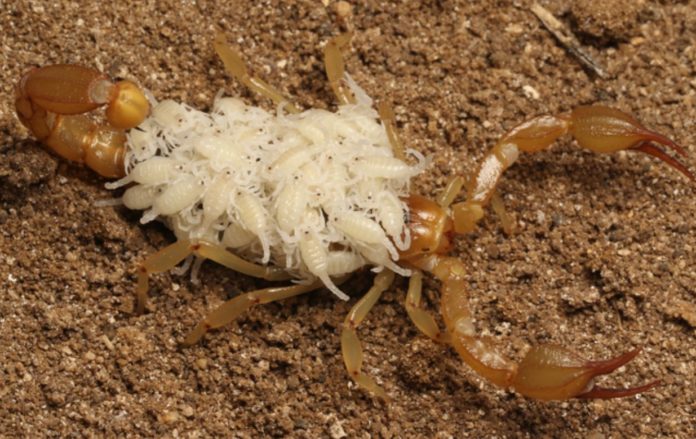California now boasts two new scorpion species, owing to the efforts of two Bay Area high school students and the California Academy of Sciences.
Harper Forbes and Prakrit Jain, active users of the community science platform iNaturalist, identified the new-to-science species of scorpions by combing through the millions of observations made by other users in the state.
Both the Paruroctonus soda and the Paruroctonus conclusus species are playa scorpions, meaning they are confined to the dry lake beds (playas) in the Central and Southern California deserts.
These newly described species contribute to a better understanding of California’s biodiversity and the areas most in need of protection for scientists, conservation managers, and the expanding communities of wildlife observers on platforms like iNaturalist—a cornerstone of the Academy’s Thriving California initiative.
In a paper that was just released in ZooKeys, the aspiring naturalists worked with Curator of Arachnology Lauren Esposito, PhD, to formally characterize the species.
In 2019, Forbes and Jain discovered an unnamed species of scorpion that had been observed at Koehn Lake, which is an ephemeral lake in the Mojave Desert. The image of the scorpion had been submitted to iNaturalist six years earlier, but no one had been able to determine what species it was.
Jain writes, “We weren’t entirely sure what we were looking at.”
“Over the next couple years,” Jain explains, they “studied scorpions in the genus Paruroctonus and learned they frequently evolve to live in alkali playas like Koehn Lake. When we returned to that initial observation, we realized we were looking at an undescribed Paruroctonus species.”
Unexpectedly, another unknown scorpion that was spotted in San Luis Obispo County in May 2021 was posted to iNaturalist not long after it was found. After studying arachnids for a few years, Forbes and Jain immediately recognized it as a new species belonging to the same genus.
They immediately got in touch with Esposito for help, which led to the discovery of two previously unknown scorpion species (P. soda and P. conclusus) and the publication of a paper with Forbes and Jain as first authors.
“Harper and Prakrit went through all the steps to formally describe a species, sampling the populations and comparing them with existing specimens in our collection,” Esposito adds. “There’s a lot of work involved, but they are incredibly passionate about this research. It’s inspiring to see that their hobby is one that advances biodiversity science.”
Both P. soda and P. conclusus are alkali sink specialists, which means they have evolved to live in alkaline basins, which are dry, salty playas with high pH soils. Each species has a relatively small geographic distribution and is only present in the two playas that bear their names: Koehn Lake and Soda Lake.
Forbes and Jain went to the lakes over their summer break to gather samples of each new species. Playa scorpions are nocturnal creatures that live in the desert, so they scoured the alkali flats during the day for settings that were most suited for them before setting out at twilight with their vials and forceps.
Since the majority of scorpions glow brightly when exposed to UV light, the researchers were able to search the wide playas with the help of blacklights while keeping a sharp watch out for their glowing subjects.
Additionally, they looked in cracks in the hard clay soil and combed through widespread alkali sink plants like iodine bush (Allenrolfea occidentalis) and bush seepweed to find for scorpions’ usual hiding places (Suaeda nigra). They were successful in gathering a sufficient sample of males and females for the study at the conclusion of each trip.
P. soda’s species range is quite tiny (a few square miles), but it is totally contained by the Carrizo Plain National Monument, a piece of federally protected area that protects this species from threats brought on by humans. Unfortunately, P. conclusus is an exception to this rule.
“While no official assessment has been carried out for either species, P. conclusus can only be found on a narrow strip of unprotected land, less than two kilometers long and only a few meters wide in some places,” Forbes adds. “The entire species could be wiped out with the construction of a single solar farm, mine, or housing development.”
Although P. soda appears to be less dangerous than P. conclusus, all wildlife is still in danger due to the ongoing threat of climate change, especially in sensitive desert areas.
Science researchers at the Academy are hoping to team up with Californian institutions of higher education and local communities as part of the Thriving California program to study biodiversity.
The project aims to stop biodiversity loss in the Golden State by utilizing scientific data, including crowdsourced data from iNaturalist, and by making environmental and science education accessible.
Jain and Forbes, who both recently graduated from high school, will study integrative biology at the University of California, Berkeley this autumn, while Forbes will study evolutionary biology at the University of Arizona.
They are currently collaborating on their next significant project, a comprehensive book of California’s scorpions, as part of their ongoing work with Esposito. They are eager to return to the field to find, collect, and identify more scorpions in addition to their research and academic activities.
“I will never get tired of going out at night to find a certain scorpion for the first time,” Jain adds. “Whether it be solving the mystery of a long-lost scorpion or discovering something new in an unexpected place, a trip to the desert is always a challenge and an adventure.”
Image Credit: Getty
You were reading: High School Students Add Two New Species Of Scorpions To California’s Rich Biodiversity
